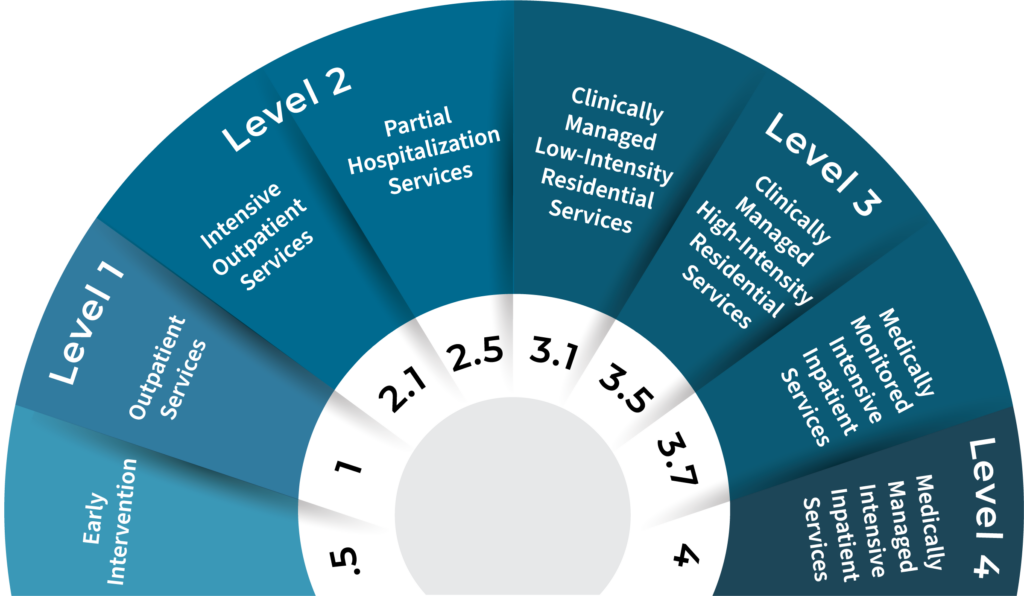There is no “one size fits all” approach to healthcare — addiction treatment is no exception.
Many rehab centers utilize a continuum of care, which means that clients enter treatment at the level of care that aligns with their needs. Then, clients can move to different levels of care as their treatment needs change.
Levels of Care generally refer to the intensity of services that are required to diagnose and treat a condition. The American Society of Addiction Medicine (ASAM) has established five levels in a continuum of care for substance abuse treatment:
The numbers at each level indicate the intensity of services provided.
How Does the Continuum of Care Work?
While every treatment center has its own approach, ASAM’s continuum of care is intended to standardize addiction treatment. When evaluating substance use treatment centers, you’ll come across all of these levels of care. The ASAM criteria are also useful for commercial insurance providers and other stakeholders.
In theory, here is how the continuum of care works. Someone with an opioid use disorder needs medically managed detox. This is the highest level of care. After completing detox, they may transition to a step down level of care, such as inpatient treatment. After completing inpatient treatment, the client may continue with treatment in an outpatient setting. If the client relapses or requires further treatment, they may transition to a step up level of care. In this case, they may return to inpatient treatment.
Throughout this process, the provider may recommend a level of care that is within their system. They may also refer clients to another center. This depends on the treatment provider and its capabilities.
How Do Providers Determine the Level of Care?
In addiction treatment, the level of care is typically determined during the needs assessment process. This is when professionals gather information in order to understand your substance use disorder(s) and make an informed decision about treatment. Questions asked in the needs assessment process may include:
- Have you participated in any kind of treatment program before?
- How often are you using and how much?
- Do you have a mental health diagnosis or history of mental health?
- Do you have any medical issues or take medications?
The questions above are only meant to serve as a reference. The needs assessment is comprehensive, and there are many factors that influence treatment recommendations.
While the services and settings will vary among treatment centers, we encourage you to use this to gain a better understanding of levels of care. This does not replace an assessment, but it may help you realize what level of care you need.
What are the Levels of Care?
The levels of care in addiction treatment are early intervention, outpatient, intensive outpatient/partial hospitalization, residential/inpatient, and medically managed intensive inpatient. The lowest level of care would be early intervention, while the highest level of care is medically managed inpatient.
Some clients may participate in all levels of care, while others may only participate in one. Continuum of care is flexible and intended to match treatment level with the needs of the patient. Learn more about each level of care.
Level 4: Medically-Managed Intensive Inpatient
Medically managed intensive inpatient is for people with severe substance use disorders who require medical stabilization. In most cases, clients are experiencing withdrawal symptoms due to dependency. They receive 24-hour medical care, medications, and counseling at this level of care in a hospital setting.
Level 3.7: Withdrawal Management / Detoxification
Pyramid Healthcare’s drug and alcohol detox programs are often the first stage of recovery for our clients. Many of our locations offer detox and inpatient treatment, making it easy for clients to transition to another level of care when they are ready.
There is no “one size fits all” approach for addiction treatment. There is no standard timeline for recovery. For these reasons, it’s important that people with substance use disorders have access to the level of care that meets their needs. Most clients with drug or alcohol addiction need care on a continual basis. Continuum of care provides flexibility and guides clients through their recovery journey.
Pyramid Healthcare’s continuum of care eases the treatment process by allowing individuals to remain in our system as they progress through treatment. We have treatment services throughout Pennsylvania, Maryland, Virginia and New Jersey for adolescents and adults.
Level 3: Residential / Inpatient
Services and settings can range in intensity for residential and inpatient programs. As the name suggests, clients live on-site, meaning they have 24-hour supervision or care. Program length can vary and is dependent on individuals’ needs, but it is usually between 30 to 90 days. Typically, days are scheduled with activities, therapy, and medical care, leaving minimal free time.
Inpatient care is often for clients who have completed medical detox and no longer require medical stabilization. In addition, clients may need inpatient treatment if their symptoms aren’t managed or if they have tried rehabilitation before unsuccessfully.
Level 2: Partial Hospitalization / Intensive Outpatient
Partial hospitalization (PHP) and intensive outpatient (IOP) are Level 2 services. PHPs are 20 or more hours per week and are designed for complex substance use disorders or co-occurring disorders that do not require 24-hour care. These may also be referred to as “day programs” as they are usually up to 6 hours per day. Partial hospitalization is not residential treatment. Similar to IOP and other levels of care, PHP can be a step up or step down depending on clients’ treatment needs.
Like PHP, intensive outpatient programs (IOP) occur in non-residential settings. However, IOP consists of fewer treatment hours per week than PHP. IOP may be ideal for clients who have complex symptoms or co-occurring disorders but don’t need residential treatment. Alternatively, IOP can be a step-down level of care for clients who have completed residential rehab.
Both programs may take place in hospitals, day treatment programs, or behavioral health treatment centers. IOP and PHP are available at select Pyramid Healthcare outpatient locations.
Level 1: Outpatient
The outpatient level of care takes place in a non-residential setting, so clients can live at home while participating in treatment. According to ASAM criteria, outpatient treatment is less than 9 hours per week for adults and less than 6 hours per week for adolescents.
This level of care may be for someone with less severe symptoms of a substance use disorder. It may also be a lower level of care for someone who has completed inpatient treatment.
Level 0.5: Early Intervention
We know that early intervention can help prevent substance use disorders. Early intervention services focus on education and resources for those who may be at risk for a substance use disorder but do not meet the diagnostic criteria. They may be misusing substances. Intervention may occur through informal counseling or structured therapy.



